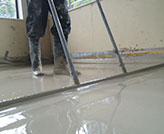When constructing a building you need to have a screed covering the subfloor so that the final flooring, whatever it may be, is as flat and level as possible. The traditional type of screed has long been a sand and cement screed in London, but today more and more people are opting for a liquid screed instead.
Let’s be upfront about this – and at UK Screeds we speak as suppliers of liquid anhydrite screeds: a sand and cement screed in London costs less than the liquid screeds that we supply and install. So, you would think that most people would choose the cheapest. However, that’s not the point.
There are several very big benefits to using a liquid screed in London instead of sand and cement. To begin with, our liquid screeds are installed using a pump. This means that we can cover an area of as much as 2,000 square feet in a day. When you use sand and cement, it has to be laid by a worker on hands and knees levelling it out as much as possible with a trowel. There is no way that a worker could get anywhere near the sort of area that we can cover in such a short space of time.

Self-Levelling
Not only that, but because our screed is in liquid form, it is what is known as self-levelling. If you think about pouring a glass of water, after a little while the surface is flat. As we have mentioned elsewhere, British Standards have a measurement of the flatness and smoothness of a screed or other surface which is SR1, SR2, and SR3 – SR1 being the best. Our screeds will almost always achieve SR1, whereas most sand and cement screeds will be no better than SR3. In addition, a sand and cement screed can curl as it dries, whereas our liquid anhydrite screeds do not.
There is another big benefit as well. Drying times for our liquid screeds are far faster than sand and cement. BS8203 estimates that the drying time for sand and cement is one day per millimetre of the thickness of the screed up to a thickness of 50mm (so 50 days) and 1/2 a millimetre a day for any more.
Compare that with our liquid screeds which are dry enough to walk on in 24 /48 hours, thus causing no delays to other contractors who need to work on the site.







